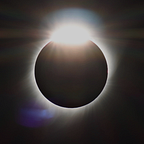Introducing Cosmic Space: The Place Where Nothing Can Escape
Imagine yourself in the vastness of space you’ll see many planets revolving around their orbits, nebulas, comets, and many other stars. You can explore all of them because they emit light, but what if there is something in cosmic space where even light can’t be able to escape? Could you able to explore them? To understand this better introduce you to a “Black hole” where gravity is so strong that even light can’t be able to escape. In our previous discussion, we explored the concept of wormholes and gained a better understanding of what they are. Now we will explore the concept explaining why wormholes are impossible to exist, leading us to discover the strangeness of black holes.
First, we need to talk about space and time: Space and time is a grand stage where the universe unfolds. But space isn’t a fixed stage and time doesn’t tick the same for everyone in space. In short, matter tells space how to bend and space tells matter how to move. As you put mass on a space-time sheet it bends and from a dip. If we place something much more massive on it, it does not just bend the stage, they are like trap doors. The universe formed a “no-go” zone where the rules change.
Formation of Blackholes
Supermassive objects of millions of billions of trillions of tons of hot plasma are being pulled inward by gravity, and the squeezed material inside with so much force that nuclei fuse, carbon burns to neon in centuries, neon to oxygen in years, oxygen to silicon in months, and silicon to iron in a day. During this phase, the core burns hotter and faster to balance gravity push by releasing energy continuously outward, and then dead. Iron is a nuclear ash, the fusion suddenly stops, and the balance ends. Now, gravity pushes the iron dwarfs as an electron, proton, and neutron present in it fuse into each other producing a shock wave that explodes outwards. This is what we call a supernova explosion and what remains of the star is now a neutron star. Its mass is around a million times the mass of the earth but compressed to an object about a few kilometers wide. Its gravity is the strongest as outside black holes and if it were any denser, it would become the one.
Singularity in Blackhole
Now we know how black holes can form let us look deeper into it. In the center of the black hole, we find the singularity. A point with all matter that has ever crossed the event horizon, all crushed to a point infinitely small. There is no memory of the things that made it as stuff disappears down the blackhole trapdoor forever. The singularity makes all things equal. The curvature of space becomes infinite, density becomes infinite, and our rules just don’t make sense. The singularity has no surface or size, it's like something divided by zero error in the universe. But our current understanding may be limited, and there could be more beyond.
Black Hole
Most Black holes form when massive stars die as previously discussed. So, moving on to the final movement of the massive stars, their inside implode, at nearly a quarter of the speed of light. This packs so much mass, so close together that it creates something so dense that it sort of breaks the stage of the universe. Precisely, it bends space-time to an infinite point where nothing can escape named singularity. A black hole with ten times the mass of the sun would be barely 60 kilometers across. If you directly look black hole it looks like nothing but space under its control is blocked by an invisible one-way border called the event horizon forms a shell around the region of space that, once entered becomes isolated from the outer universe forever.
Because the blackhole trap door deforms space so much that even light can’t be able to escape. And with nothing escaping to transfer information from inside, it’s impossible to tell what it really looks like. But we can still observe them because of their effect on matter. Like, casually planets revolve around massive stars. Similarly, a black hole has a disc of matter orbiting outside the event horizon. This matter becomes incredibly hot as close orbits can speed their matter up to half of the speed of light and tiny amounts of collisions between particles heat them to a billion degrees, making the space around these blackhole incredibly bright.
Despite decades of study, the secrets of black holes continue to elude even the brightest minds in science. Their strange behaviors and properties remain shrouded in mystery, leaving us with more questions than answers.
I believe things cannot make themselves impossible.
_Stephen Hawkings_
